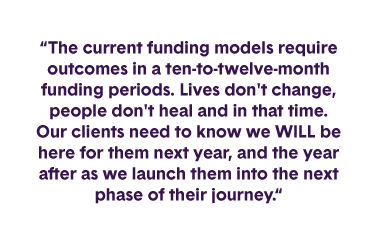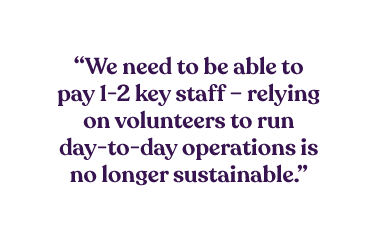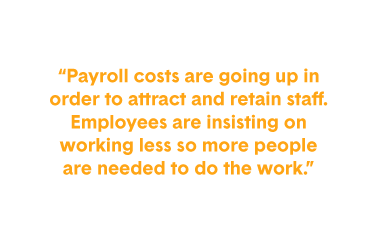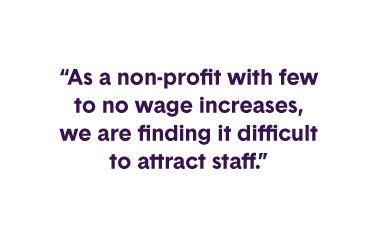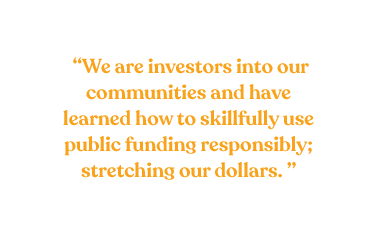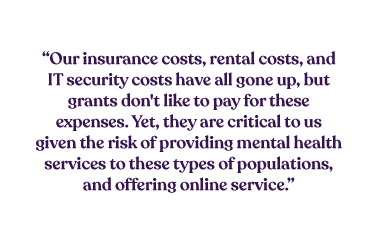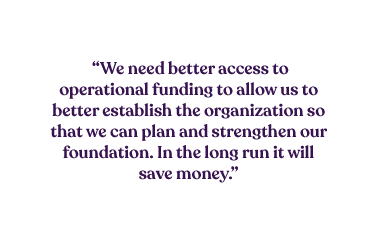Facing the Storm:
State of the Sector 2023

Facing the Storm
If you feel the pace of life is accelerating, you’re not alone. In the last year, artificial intelligence has changed the way we work. Climate change brought unprecedented heat, smoke and drought. Polarization is escalating. Prices are rising. As humans become more interconnected in urban and online environments, we communicate more, generate more ideas, innovate more, and produce more [i]. For better and for worse we are changing faster, and this rate of change impacts us all.
For Alberta nonprofits, global trends are converging with persistent local challenges: soaring demand for services, historical underfunding, and pervasive burnout. Facing the Storm: Alberta’s Nonprofit State of the Sector 2023 gives insight into the state of the sector in turbulent times and perspectives on emerging issues:
Revenues stabilized, driven by an increase in earned revenue, at the same time as expenses soared, placing pressure on communities we serve, employees, and nonprofit operations.
Nonprofits with fixed funding streams grapple with increasing expenses and can increase staff salaries only at the expense of programming.
We are adapting to a blend of in-person and remote work, with employees finding relief from reduced daily commutes but missing out on more personal workplace relationships.
Nonprofits demonstrate widespread awareness of diversity, equity, and inclusion initiatives and identify strides to be made towards equitable outcomes - with few resources to do that important work.
Nonprofits are uniquely positioned to act locally in response to the impacts of climate change and polarization felt around the world.
While nonprofits are in turbulent times, our sector shows deep commitment to making our communities stronger and more vibrant, and we know we can count on each other to get there. This year is not merely about weathering the storm; it is about ‘facing the storm’ and charting a course for a resilient and impactful future.
“Nonprofits are facing a storm. But we are all in it together.”
- ROUNDTABLE PARTICIPANT
The Storm We Face

That Money Thing
In 2023 Alberta nonprofits are experiencing low but stabilizing revenue, increasing expenses, recruitment and retention challenges, and staff burnout. Demand for nonprofit services is increasing as more Canadians struggle. More Canadians are accessing food banks [ii] and other nonprofits to fill their basic needs [iii], 62% of whom report difficulty keeping up with the rising cost of living. This affordability crisis is affecting nonprofit staff, members and clients, board members, volunteers, and overall nonprofit operations. Alberta nonprofits are overwhelmingly concerned with their ability to meet demand, with 63% finding it challenging or very challenging.
"30% of Albertans expect to access charitable services to meet their basic needs in the next 6 months, compared with 24% of Canadians."
(IPSOS-REID 2023)
An Affordability Crisis
Nonprofits are feeling the crunch in 2023 - but leaders are most concerned about their staff.
Nonprofits are feeling the crunch in 2023. Approximately ⅓ of respondents in CCVO’s 2023 nonprofit survey report their “ability to afford standard operations” as more challenging this year. 82% of respondents saw expenses increase, and half of these respondents report that expenses increased “substantially.” Survey comments and focus group conversations reveal nonprofit leaders are even more concerned about affordability for their staff.
Behind the strain experienced by nonprofits is an affordability crisis felt by many Albertans. Statistics Canada revealed 2022 had the largest Consumer Price Index (CPI) increase in Canada since 1982 [v]. Prices remain high in 2023 but are rising at a slower rate [vi] (with the exception of gasoline). These rising costs add pressure to household budgets and to an already-strained nonprofit sector. Cost increases coincide with the end of emergency financial supports during the COVID-19 pandemic, and after many years of poverty rates trending downward in Alberta and Canada, early estimates show an uptick over the last two years [vii]. As of May 2023, an astounding 27% of Albertans were expected to access charitable services for their basic needs in the following 6 months. Nationally, 7/10 of those expecting to access charitable services for basic needs will be doing so for the first time. This includes more employed people [viii] and, according to nonprofit leaders, nonprofit staff. Albertans working in the sector earn 34% less than the average [ix], meaning they are more vulnerable to changes in the cost of living.
Vulnerable people who rely on inadequate social supports to survive are falling further behind and relying more heavily on nonprofits [xi]. Fewer Canadians are donating to charities, and support is tilting towards large nonprofits and away from smaller ones [xii]. With fixed funding streams, nonprofits are grappling with increasing expenses and can only increase staff salaries at the expense of programming. Board members and other volunteers are similarly reported to be under more strain.
- 37% growth in share of Calgarians renting (2011-2021) [xvi]
- 31.7% of renters in Alberta are in unaffordable housing
- 40% of recent renters in Alberta live in unaffordable housing
- 12% increase in apartment rental prices in Calgary, compared with 1.3-1.8% increases in dwelling ownership [xvii]
2022 sees the highest increase in major expenses in Canada since 1982 [x]. In Alberta: 6.4% overall, 10.5% in transportation, 8.3% in food and 6.6% in shelter.
Addressing the affordability crisis is crucial to attracting and retaining a qualified workforce, and the impacts of the housing affordability crisis are particularly concerning. Rising housing costs among renters far outpace those experienced by homeowners. Renters represent a growing demographic that is more than 2X more likely to live in unaffordable housing in Canada [xiv]. A new Statistics Canada report shows recent renters pay substantially more than longer-term renters, with young people and new Canadians over-represented among recent renters [xv]. Young people and new Canadians also form a substantial portion of the nonprofit workforce.
“...inflation is expected to have a "three-pronged impact on the sector, increasing operating costs and demand for services while driving down donations."
(JENSEN, 2023)
SURVEY SAYS
Nonprofit ability to meet demand for services:
63%
report ability to meet demand as challenging / very challenging
"Some of my staff have been using food banks and relying on meals we provide as part of our programming."
- FOCUS GROUP PARTICIPANT
municipalities are responding to the crisis
On September 16, Calgary City Council voted to pass Calgary’s Housing Strategy, which included crucial recommendations from the Housing and Affordability Task Force. In the days leading up to this decision, CCVO and 93 nonprofit signatories called on City Council to accept the recommendations from the Housing and Affordability Task Force in order to keep Calgary affordable for the workers who keep our sector alive and well.
Revenues and Expenses
While revenues stabilize, expenses skyrocket.
2023 witnessed stabilizing revenues and soaring expenses among Alberta nonprofits. Earned revenue increased the most and donations the least. Insurance, staff salaries, and program operations were the most notable cost increases among Alberta nonprofits (Figure 3).
Conversations with the sector revealed nonprofits trying to diversify revenue streams alongside rising competition for funds (particularly operational funding) and as funding requirements fail to meet community need. Some nonprofits have tried circumventing the need for revenue, developing cost neutral responses like community fridges or closets to meet needs. Others are turning to social enterprise, operating related businesses to raise revenue for their mission. Still others are trying to secure funding through sources that are not obviously aligned with their activity or mandate in order to access funds not otherwise available to them.
These innovations are admirable, but conversations with nonprofit leaders identify them as responses to funding programs that don't meet the needs of the sector in quantity and design. Provincial funding, for example, has decreased in the last 15 years, while the population grows and inflation reaches new heights (Figures 1 and 2); and nonprofit leaders identify a disconnect between nonprofits, funders and government. They indicate they should have a role in the creation and evaluation of funding streams to ensure alignment with the needs of local communities and the realities of running a nonprofit. For example, funding objectives often do not support long-term relationship-building or core operations, leading nonprofits to seek funding that alters their activities and to deliver one-off programs that align with grant objectives. Meanwhile, nonprofit leaders state that achieving their mission is strongly dependent on relationship- and trust-building, requiring a consistent presence and consistent programming in the community.
In 2021, only 17.7% of taxfilers claimed donations on their income tax returns [xviii]. This is the lowest percentage ever recorded.
Nonprofit funding shrinks while population and inflation grow.
Stabilizing revenues offer a glimmer of good news, but there are caveats. While more nonprofits report revenues similar to or slightly higher than the year before, this comes after record lows. Secondly, we can assume that those responding to the CCVO survey are those that kept their doors open.
Accessing more operational funding is a top priority for the sector in 2023. Organizations need staff to maintain professionalism and accountability and to preserve bandwidth for service delivery. Staff, particularly in leadership positions, are wearing too many hats and putting in unpaid hours to keep their organizations afloat. Many commented on their lack of time to do strategic work or engage in the important task of connecting with their staff and their mission. Staff report cutting into service delivery in order to complete administrative duties. The amount of operational funding typically allowed on project-based grants varies from 0-12%, while some studies show higher success with overhead valued at 30-35% [xix]. In fact, studies analyzing the activities of nonprofits noted their budgets often ”defied plausibility,” with administrative work going unaccounted for in budgets [xx]. While this is not a new issue, it appears to have reached new heights as expenses rise and operational funding becomes ever scarcer.
"We are direct service rich and administration poor."
- ROUNDTABLE PARTICIPANT
SURVEY SAYS
Expense and revenue trends:
65%
of respondents report revenue is increasing or staying the same
82%
of respondents report a slight or substantial increase in expenses.
Rapid Pace of Change.
The world at large continues to grapple with an increasing rate of change caused by complex issues [xxi]. Within the last year in Alberta, artificial intelligence has emerged as a more accessible tool that is already altering the meaning of Digital Transformation. Climate change has accelerated extreme weather, including unprecedented heat this year. Equity goals remain on the horizon, but awareness is rising. Polarization persists. We wanted to know the extent to which these changes are affecting the capacity of nonprofits.
"We have always done advocacy, but everything is moving so fast now. The decision is made before we even get in the room."
- FOCUS GROUP PARTICIPANT
Diversity, Equity and Inclusion
Nonprofit commitment to Diversity, Equity, and Inclusion practices varies according to leadership.
Nonprofits have a key role to play in DEI and should lead the way in setting a high bar, but they are underperforming in some areas. Nonprofit workers earn less than others in comparable jobs and on average earn 34% less than other sectors [xxii]. Female employees dominate the Alberta nonprofit sector, but Statistics Canada shows their annual wages and salaries remain lower than their male coworkers by 14% [xxiii]. The lowest average annual salaries are those of visible minority employees, who form a large portion of the nonprofit workforce [xxiv]. Other research finds nonprofit boards consistently less diverse than the Canadian population [xxv].
Half of our survey respondents self-reported as having “equitable policies and practices in place.” While awareness of DEI seems hearteningly widespread, equitable outcomes are not yet as evident. An Imagine Canada survey suggests awareness is not always linked with effective action. Small and medium nonprofits, as well as white-led nonprofits, are least likely “to be intentional in their pursuit of [DEI] [xxvi].” BIPOC-led organizations are most likely to do so. At the same time, BIPOC-led organizations are most likely to encounter funding challenges.
Conversations with the sector provide interesting insights. Some asked about barriers to filling out our survey – and whether BIPOC representatives were as likely to fill out surveys. Some asked whether the sector needs to better identify what success looks like in DEI. This could be appealing across the spectrum of perspectives we heard in the sector about DEI – from those who think DEI needs to go further to those who express it has gone too far. Shared understanding and vocabulary can help folks identify where they have common ground and common values and where those commonalities diverge [xxvii]. Identifying DEI targets also helps our sector celebrate wins together. Goalposts often shift along the way; celebrating helps us understand the journey. The need to identify what success looks like, and why, was reflected in focus groups, where participants recounted instances where they lacked understanding of DEI objectives, and shared factors that may have contributed to that lack of understanding, including generation or local norms.
These conversations underlined the importance of having data that holds our sector accountable and a workforce strategy that strives to make progress accordingly. As with last year, they also highlighted the lack of capacity nonprofits may have to lean into DEI work while putting in overtime to keep their doors open. Nonprofits need appropriate funding to be able to do this work in a meaningful way.
Survey Says
Where nonprofits are on their DEI journey:
50%
of respondents felt they have “equitable policies and practices in place.”
VOICES FROM THE NONPROFIT SECTOR
"[DEI is] a critical area that requires investment but which the organization is challenged to move forward on in a significant way due to financial challenges."
- FOCUS GROUP PARTICIPANT
"Our biggest barrier re: DEI is being able to provide opportunities to remote parts of the province."
- FOCUS GROUP PARTICIPANT
"We are in between the process of learning, which we believe is cyclical and ongoing, and the process of transforming our policies and practices, which we also believe is cyclical and ongoing."
- FOCUS GROUP PARTICIPANT
Digital Transformation
A lagging sector in a changing digital reality.
Digital skills are expected to be necessary for all employed people, globally: the World Economic Forum estimates that by 2030, 90% of jobs will require digital skills [xxviii]. For nonprofits, digital literacy is increasingly important for fundraising, accessing sector information and support, connecting with networks, and communicating outcomes [xxix]. It is critical for individuals served by nonprofits, for example to access education and employment [xxx]. And it will be critical for nonprofits to remain competitive employers: communicating the benefits of their workplaces and accommodating the diverse needs of staff, including remote and hybrid workers.
Only ½ of rural communities and 1/3 of First Nations communities have access to “basic” upload and download speeds set by Canada’s communication regulator in 2016 [xxxi].
Few CCVO survey respondents are experimenting with the full array of digital tools available - the majority use basic, off-the-shelf technology. These findings were reiterated during focus groups with respect to clients, members, staff, or board members. Reasons cited included lack of time and bandwidth and lack of access. However, a surprising 16% of survey respondents are using or experimenting with AI technologies, despite programs like ChatGPT emerging as recently as November 2022. Alberta nonprofits also appear to outpace their corporate counterparts, with estimates that 4% of Canadian businesses are using AI [xxxii].
In Alberta and Canada, there remains a digital divide. Rural and First Nations communities, for example, are not well connected to the internet. But the digital divide is not just about access. It is also about digital literacy – the ability to engage with new technologies – and the ability to capitalize on digital opportunities [xxxiii].
Nonprofits most frequently experience challenges with digital literacy and opportunities. They also have less capacity to attract the talent that would improve their skills, in comparison with a for-profit sector that has put considerable effort into attracting and retaining tech talent. Partnerships with educational institutions through Work-Integrated Learning are one way in which nonprofit needs could be understood and met. There are win-win opportunities here: tech talent can learn about and cater outputs to social organization competencies and unique needs, while social organizations can improve their competencies [xxxiv]. Further, student engagement with local nonprofits creates opportunity for young people to develop a stake in nonprofit activities [xxxv].
Digital technology has the potential to support greater equity. For example, it has never been easier to provide information in multiple languages, which can help new Canadians access information and opportunity. AI technology also has the potential to increase nonprofit capacity and improve results, and its user-friendliness lowers barriers to entry. It is unclear whether this will give the sector a competitive advantage overall, or whether it will simply raise the bar across all sectors.
Technological advancement comes with pitfalls. Social media has become increasingly polarizing, and its use may expose more nonprofit workers to rising anger and hate. These issues point to a need to review health and safety guidelines in nonprofits and for government policy to limit the physical and mental health risks associated with overuse of electronics and social media. France, Germany and recently Ontario have taken steps to limit work-related electronic communication to work hours, dubbing them as “right to disconnect” laws. Some German companies go as far as automatically deleting emails sent outside of work hours or during holidays [xxxvi].
France and Germany protect workers from excess work and computer use through “right-to-disconnect" laws.
Finally, there is concern about the effects of emerging technology (such as AI) on jobs. Briefs written for the Government of Canada suggest that more data is needed to determine the benefits and drawbacks of the use of AI in the workplace. Possible repercussions range from some job loss, to evolving job descriptions, to adapting education and training for a changing job market [xxxvii]. Experts predict that new AI technology will be “labour-complementary” rather than “labour-replacing” [xxxviii].
"There is little to no funding available to branch out in these areas, and competition is steep for grants. This, being such a prevalent and encompassing area, should be supported better, and automatically, as a rule, to help organizations be relevant."
- FOCUS GROUP PARTICIPANT
Survey says
On technology nonprofits are using:
3%
use AI technology regularly
74%
use basic, off-the-shelf technology to support Administration
13%
use AI but not regularly
Tumultuous Times.
Staff Recruitment and Retention
Staff recruitment and retention continue to be a challenge among nonprofits.
Staff recruitment and retention continue to be grave concerns for the sector in Alberta and across Canada [xxxix], with only 5% of our survey respondents finding staff recruitment easy or very easy. Reasons span mental health, appropriate pay, appropriate skills, and ability of staff to meet demand. Many Alberta nonprofits are experiencing a loss of staff to the public and private sectors, which often offer higher wages and/or more job security.
28% of [Canadian] nonprofits report that staff are working more hours to take on work normally done by volunteers and 21% say that the volunteer shortage is leading to employee burnout.”xlii
Volunteer recruitment was cited as challenging or very challenging by 62% of respondents, again mirroring trends across Canada. According to Imagine Canada, this decline in volunteer engagement can significantly reduce nonprofit capacity. Their survey found that 58% of charities (and even more nonprofits) do not have paid staff, and that for those that do, paid staff benefit from the contributions of volunteers [xl]. Nonprofits across Canada have reported that the increased challenge of recruiting volunteers is leading to a reduction – and sometimes even cancellation – in programs and services offered [xli]. Focus groups in Alberta provided more nuance, identifying that many of the services they provide cannot be provided by volunteers. Nonetheless, they felt that younger people are more likely to be interested in volunteering than donating. If clear roles and programs are available for volunteers, this can be of great benefit. If not, coordination of volunteers requires additional resources, staff hours, and programming.
Nonprofit leaders described efforts to make nonprofit workplaces attractive, including benefits packages, workplace flexibility, and continuing education. Workplace culture also figured prominently, with an emphasis placed on the role of leadership in creating workplaces conducive to good mental health. However, nonprofits shared with us that measures such as these did not make up for low wages in the current affordability crisis. Some nonprofits reduced the number of workers they had on staff to pay remaining staff members more, which also reduced the amount of work – clients helped, outputs produced, community members reached – that they could complete. In brief, nonprofits felt adequate funding is needed to support their staff and communities.
Additional ideas proposed by survey respondents for alleviating recruitment and retention difficulties included: tax incentives for nonprofit workers, recruitment of newcomers, and addressing some of the rural-urban inequities that exist when it comes to running nonprofit casinos. An empowered sector, a workforce strategy, and a door to government would help this feedback from the sector to enrich policy among funders and governments.
SURVEY SAYS
Nonprofits’ ability to recruit:
56%
of those who searched for staff found it challenging or very challenging
62%
of respondents found volunteer recruitment challenging or very challengingMental Health
Burnout and other mental health challenges persist.
While mental health challenges among staff were often tied to the COVID-19 pandemic in previous years, increasingly external stresses – like climate change, war, and polarization – are beginning to play a role in employee mental health. More than half of nonprofits are concerned or very concerned about the mental health of staff, and 20% of survey comments specifically mention “burnout” or “fatigue” – words that were also common at roundtables and focus groups. Research suggests we can anticipate a lag effect from stresses such as the COVID-19 pandemic [xliii][xliv], which are being exacerbated by new and additional stresses.
Solutions offered for combatting this trend included providing more mental health benefits, more sick leave, and more workplace flexibility, as well as looking to leadership to set a good example for mental health in the workplace. Research throughout the pandemic also showed that workplaces that had invested in disaster planning had better mental health outcomes throughout the pandemic [xlv].
"Staff morale, mental exhaustion, burnout – these conversations with staff are on the rise."
- FOCUS GROUP PARTICIPANT
SURVEY SAYS
Mental health among nonprofit staff:
52%
of nonprofits are concerned or very concerned about the mental health of staff
Anger and Hate
More than 1/3 nonprofits are affected by rising hate and anger.
The last decade has seen more division and growing concern about the rise of anti-government, anti-semitic, islamophobic, anti-Asian, and misogynistic sentiments [xlvi]. Public opinion polling dating back to 2020 suggested these trends were less pronounced in Canada than in the US. At that time, Canadians were more likely to indicate greater satisfaction with our democracy. Other studies suggest we should prepare for “spillover” from trends in the US [xlvii]. They warn of the consequences of the erosion of trust, which leaves room for misinformation that weakens democratic institutions. Pollara’s Rage Index in Canada recently indicated increasing anger in Canada – and identified Alberta as the most angry province [xlviii].
Why we are seeing these trends is a matter of debate. Some feel the responsibility lies with political parties themselves, who increasingly use anger to mobilize their base:
Partisans exploited the utility of anger to motivate and mobilize their base. Unlike fear, which is triggered by unfamiliarity, anger is triggered by moral outrage. Soon, polarization became a tactic and a strategy to mobilize the base and raise money. A new communications business model was built around stoking outrage and weaponizing anger [xlix].
Some point to media. As news outlets lose public funding and rely increasingly on advertising revenue, there is more pressure to sell the news [l] - and rage sells.
Just over 1/3 of CCVO survey respondents experienced a big or moderate impact from rising hate and anger. Concerns cited in comments were diverse. Resentment, anger, and hate could arise around age, sexual orientation, gender, ethnicity, political affiliation, medical status, or quality of service. These negative feelings could also arise around the airtime given to these issues. Some respondents indicated concern that people have become more reactive and less patient; about the effects of social isolation; about social disorder and vandalism; and about bullying, threats, and security. There were concerns that the isolation of the COVID-19 pandemic had made us more self-centred. Some noted that people are now more likely to seek out topics of conversation that make them angry. Some suggested it wasn’t so much hate and anger on the rise – which indicates a specific target – but general frustration, particularly associated with economic strain and government failure to address it. There was a sense among commenters that pressure was building.
Imagine Canada suggests the nonprofit sector can play a crucial role in “creating connections during divisive times [li].” Our work as nonprofits can advance connection, mutual care, and the enrichment of human life in our communities. It can remind us how to talk to each other. And our sector has the numbers to have an impact: nonprofits have a stronger presence in communities than political parties [lii], with an average 345 nonprofits per Alberta electoral district (see map below). Our sector can also call out tactics of division rather than cater to them. However, there are limitations to be overcome within our sector [liii]: our capacity to build coalitions and to “mobilize the community on a large scale" is limited; and our expertise needs to be better recognized to leverage our strengths, with nonprofits acting as strategic partners rather than service-delivery partners. This points to a need for more adequate funding to increase capacity, for an empowered sector, and for healthy collaboration with government.
SURVEY SAYS
Nonprofit experiences of anger and hate:
37.5%
of survey respondents feel the rise of anger and hate has had a moderate to big impact on their organization’s operations.
"When societal trust breaks down, people don’t feel safe volunteering."
- SURVEY RESPONDENT
A Changing Climate
Drought, smoke and heat affect majority of nonprofits.
Over the last 6 months, Alberta nonprofits have anecdotally reported the effects of climate change: hosting evacuees from seniors’ homes, cancelling work in remote areas, and cancelling outdoor events due to smoke and heat. In our survey, 43% of respondents felt that climate change has had a big or moderate impact on their operations, and only 26% felt it had no impact at all. This was surprising in the context of national studies performed earlier that year. In January 2023, the Canadian Survey of Business Conditions performed a survey in which only 8% of nonprofits reported concern that climate change or weather would be an obstacle in the next three months [liv].
But 2023 brought unprecedented extreme weather events that were felt by many Canadians. In 2023, the world broke the record for the hottest day on Earth twice, on consecutive days [lv]. We saw the worst wildfire season in recorded history, as measured by area burned [lvi]. In Calgary, we inhaled more than 15 times as much smoke as previous generations [lvii].
Researchers had previously anticipated impacts we could expect as a sector. They warned that nonprofits would be called upon to set up cooling and warming centres and to check on vulnerable clients; of increasing need for immigrant and refugee settlement services as places become inhospitable [lviii]; of nonprofits’ assets being damaged; of staff being unable to work; and of rising costs and lower availability of insurance [lix]. They anticipated impacts to seniors – an important consideration in Alberta, where 1 in 5 will be seniors by 2046 [lx]. Seniors are more vulnerable to the effects of climate change due to increased physical sensitivity to heat and smoke, disability, isolation, and limited income [lxi].
Impacts of climate change reported by Alberta nonprofits were more diverse than what we’d heard anecdotally. Smoke and the impact on air quality made a big impression on Albertans this year. The effects of climate change on seniors were cited specifically. Additional impacts included: staff unable to get to work; fewer tourists at museums; damage to property from extreme weather; droughts affecting agricultural production, animal feed and water-based tourism; increasing costs of food; investing in air filtration and air conditioning; disaster planning; effect of smoke on performers; reduced outdoor activity; rising insurance costs; and extreme heat impacting the opioid crisis. Several respondents placed an emphasis on the negative impacts of taxes, often the carbon tax, on affordability, rather than climate change. A portion questioned the veracity that climate change is occurring. There were no notable differences in response between cities and towns in Alberta, or between urban and rural.
Despite the survey results, climate change did not come up often in focus groups and roundtables. When it did, it was typically in the context of its effect on staff mental health, rather than its effect on organizations. Research suggests this may be indicative of the disconnect between the urgent relevance of everyday challenges that nonprofits must solve and of the enormity and abstractness of climate change [lxii]. Again, this points to the sector’s need to find its footing – through adequate funding and the kinds of support provided in a workforce strategy – to navigate new challenges posed by climate change.
SURVEY SAYS
Nonprofits affected by climate change:
74%
feel climate change has impacted their operations
VOICES FROM THE NONPROFIT SECTOR
"Forest fire smoke causes problems, with indoor air quality causing cancellation of programming. Flooding threatens our location and damage to our only assets."
- SURVEY RESPONDENT
"Especially among younger generations, there is growing anxiety about the future due to climate change. We encounter more individuals grappling with existential distress and eco-anxiety."
- SURVEY RESPONDENT
"More refugees from humanitarian crises are arriving in our region."
- SURVEY RESPONDENT
Remote Work
Remote and hybrid work persists.
Remote and hybrid work persists among Alberta nonprofits, with the largest share of survey respondents reporting hybrid workplace arrangements. Organizations most likely to be “fully in the office” are social supports, family supports, seniors supports, mental health, sports & recreation organizations, and education & research organizations. Organizations outside of Edmonton and Calgary are least likely to be fully remote.
Though remote work in Canada has been on the decline since mid-2021[lxiii], it is expected to be here to stay [lxiv]. As of August 2023, just over half of Canadian employers (55%) have finalized their approach to remote or hybrid work [lxv]. Consistently, more women than men and more people with higher levels of education have worked from home over the last 3 years in Canada.
Avoiding the daily commute is one benefit of working from home that employees want to keep [lxvi]. Research supports the benefits of lower commute times and more pleasant commutes – on happiness, relationships, and pocketbooks [lxvii][lxviii][lxix][lxx].
Providing the flexibility of hybrid work is also considered an important response to the burnout that has been experienced throughout the sector. Overall, impacts to productivity and efficiency have not yet been reported [lxxi].
But there are drawbacks to remote work. With remote work comes increased use of electronics, and excessive use of electronics brings health risks - neck and back problems, chronic disease, and increased risk of blood clots [lxxii]. Trust, dialogue, and innovation are more likely to develop through in-person and multi-layered relationships, and employees have found themselves yearning “for the camaraderie, the casual chats by the coffee machine, and the sense of belonging that typically came with the pre-pandemic workplace culture [lxxiii].”
Clarity around goals and institutional roles can also be easier to provide in person. When working remotely or in a hybrid model, it is thus more important to be explicit about roles, action items, and direction. It is also important to create social opportunities. Different organizations across Canada have addressed this in different ways, such as by creating online workshops or in-person “team days” and by including staff in developing such approaches.
VOICES FROM THE NONPROFIT SECTOR
"We have remote working capability, but most people are choosing to be fully in the office because of effectiveness and productivity (although in-office is not mandated). We are fortunate to have a healthy and vibrant working environment."
- SURVEY RESPONDENT
"Because we shifted to a fully remote work environment, we have been able to add staff in other provinces to engage in projects nationally. This also opened up the pool of potential employees when we were recruiting."
- SURVEY RESPONDENT
Gaining Solid
Ground

We have begun charting the course for a resilient and impactful future in which advocacy plays a strong starting role.
Our sector has faced a storm in 2023: new and complex issues, an accelerating pace of change, and persistent challenges. We have also begun charting the course for a resilient and impactful future in which advocacy plays a strong starting role. With this in mind, we checked in with Alberta nonprofits about their perspectives on advocacy.
Overwhelmingly, Alberta nonprofits want to see stronger provincial advocacy for the sector. We heard that while our sector is diverse, it shares common concerns fundamental to organizational health and sustainability and common challenges engaging with government bodies. At the national level, for example, governments have been all too likely to ignore the nonprofit sector, and “though the sector provided 300 out of 700 submissions to the federal budget, the budget itself referenced charities 10 times and businesses 187 times [lxxiv].” Some Alberta nonprofits have prioritized contracting outside help to garner government attention, but most nonprofits do not have the resources to do so. We need collaborative effort on the issues we have in common.
But not all our issues are held in common. Small nonprofits expressed having less capacity to advocate, as well as dwindling funds compared to larger nonprofits – a claim supported by the data. They need champions. Some nonprofits expressed a need for advocacy specific to their sub-sector. We heard conflicting needs: nonprofits want to be included in dialogue and decision-making and want to be heard, but they also have limited time, if any, to participate.
Through The Nonprofit Vote, CCVO and its partners are building space and capacity for nonprofits to communicate about sub-sector issues. We will continue to work together to solve the issues we hold in common by building on this platform.
The Nonprofit Vote: A home for nonprofit advocacy.
During the 2023 provincial election, The Nonprofit Vote hosted an ArtsVote campaign, which saw 758 submissions through our platform. The result of this advocacy saw Premier Danielle Smith add ‘Arts’ to a Ministry title, elevating its importance and prioritization for the newly formed government. The Premier referenced the advocacy from the arts community as having a direct influence on this decision.
Finding time to complete necessary tasks within our organization is a struggle. Doing anything over and above basic operations is almost impossible.
- FOCUS GROUP PARTICIPANT
survey says
75%
of nonprofits expect moderate to significant benefits to their organization from stronger, collaborative provincial advocacy
Voices from the nonprofit sector
The Nonprofit Vote is a collaborative that unites and amplifies nonprofit voices. We share the invaluable contributions made by our sector and provide a platform for shared advocacy.
Emerging Stronger Together

Policy Priorities Progress
During the provincial election in May 2023, CCVO and The Nonprofit Vote called for provincial parties to commit to 5 Policy Priorities in support of Alberta’s nonprofits.
The survey and focus groups indicate that nonprofit priorities continue to align closely with these Policy Priorities – goals we expect will take years to achieve. We have gained some traction on these priorities already, and with a new government now in place we are charting a course to make even more headway.
A Workforce Strategy:
Undertake a labour market study and develop a strategy to stabilize the nonprofit workforce by addressing recruitment and retention concerns.
Traction:
We are working with the Government of Alberta to advance a feasibility study to prepare for a larger labour-market study.
Appropriate Funding:
Invest $300 million over 3 years in a Community Prosperity Fund for nonprofits to address the impacts of the pandemic, inflation, and historic under-resourcing to ensure this essential sector is here for Albertans when they need it most.
Traction:
Amid a workforce crisis, historic underfunding, a global pandemic, inflation, and surging demand, our sector rang the alarm in 2023. Through The Nonprofit Vote, we launched a campaign for emergency funding that became leading news on 5+ news outlets and led a Day on the Legislature that brought the issue forward to 8 Ministries, the Premier, and caucuses, but we have yet to gain traction on this priority.
Better Data Collection:
Collaborate on data collection to ensure government and nonprofits can be more effective through data-informed actions.
Traction:
For years there has been a major gap in base-level data about the nonprofit sector. In a demonstration of what’s possible, CCVO undertook a major project in 2022 to gather data on the location and sub-sector of all nonprofits in Alberta. We continue to work closely with partners, including the Government of Alberta, to move forward on better data collection for the sector.
An Empowered Sector:
Make funding go further by cutting red tape and sharing decision-making with nonprofits on the most effective allocation of government dollars.
Traction:
No gains yet on this priority.
A Door To Government:
Explore creating a dedicated space in government to share challenges, successes, and opportunities, with renewed partnership from the Government of Alberta to address them.
Traction:
We have submitted a brief for a Door To Government for Alberta’s Nonprofit Sector, and we anticipate engaged discussion with the sector and across Ministries through the Alberta Nonprofit Voluntary Sector Initiative (ANVSI) on this issue.
Of these 5 priorities, we have gained footing on 3 of the 5: A Workforce Strategy, Better Data, and A Door to Government. This year, we need your help to progress the remaining two:
Appropriate Funding: Short-term stabilization funding to address immediate needs; and
An Empowered Sector: Long-term strategic planning for appropriately funding the nonprofit sector in Alberta.
Charting A Course
Because of our collective advocacy on the policy priorities to date, we know that right now our government partners and other funders are listening, and they want to hear from nonprofits. The pandemic shone a light on the need for funding reforms, many funders responded, and they are ready to do more on making funding work better for nonprofits. CCVO is launching an opportunity for Alberta nonprofits to give direct input into the immediate funding priorities for the sector and the long-term strategies for funding the sector. This effort is an important contribution that will spur the much-needed funding reforms that our sector has long been calling for.
We know that our emergency call for funding was a bold ask, and we will continue to be bold, because we know that nonprofits need stabilization to help get us through this moment in time. We know that funding reform is a big undertaking, and we are committed to it, because nonprofits have asked for it. The best chance of succeeding is with a clear set of funding priorities for the sector and a clear understanding of the funding mechanisms that work for nonprofits. And we cannot do it without your participation.
By joining in this process, nonprofits will shape:
CCVO’s 2025 provincial budget submission with a clearly itemized list of funding priorities for the nonprofit sector
Recommendations to funders on how to fund the sector at an appropriate level in the appropriate way
An understanding of the funding reforms needed to make funding to the sector function at the highest and best use for nonprofits
Sustained collective advocacy that will allow you to make a compelling case for your organization and sub-sector, while contributing to a long-term vision for an appropriately funded sector
We know that nonprofits are facing down a storm; face it down standing shoulder to shoulder with friends and colleagues in the sector, and let’s chart a course together.
Summary of Recommendations
This year’s research included many useful recommendations from Alberta’s nonprofit-sector leaders and from the literature. We thought we’d put them all in one place for your perusal! Recommendations span small actions you can take in your own nonprofit to sector-wide efforts. Sector-wide, the most striking finding was that Alberta nonprofits need Operational Funding to keep their doors open and maintain service and program delivery. They need additional funding to address bigger issues like climate change, polarization, and diversity, equity, and inclusion.
Within report themes, the following recommendations emerged:
Diversity, Equity, and Inclusion: Identify what success looks like in DEI, as a sector and within our own organizations. This will improve understanding of the work, help our sector celebrate wins together, and help folks identify where they have common ground and common values (and where those commonalities diverge).
Digital Transformation: Partnerships with educational institutions through Work-Integrated Learning are one way in which nonprofit needs could be understood and met. There are win-win opportunities: tech talent can learn about and cater outputs to social organization competencies and unique needs, while social organizations can improve their competencies. Further, student engagement with local nonprofits creates opportunity for young people to develop a stake in nonprofit activities. Some Alberta nonprofits also suggest technology and technological support should be included in funding as a rule.
Recruitment and Retention: Nonprofit leaders described efforts to attract and retain employees including: benefits packages, workplace flexibility, continuing education, and tax incentives for nonprofit workers. Workplace culture also figured prominently, with an emphasis placed on the role of leadership in creating workplaces conducive to good mental health. However, nonprofits shared with us that measures such as these did not make up for low wages in the current affordability crisis. Addressing some of the rural-urban inequities that exist with nonprofit casinos was cited as one way to improve rural nonprofit revenues.
Mental Health: Solutions offered for improving workplace mental health included: mental health benefits, more sick leave, more workplace flexibility, and looking to leadership to set a good example for mental health in the workplace. Research throughout the pandemic also showed that workplaces that had invested in disaster planning had better mental health outcomes throughout the pandemic.
Anger and Hate: Imagine Canada suggests the nonprofit sector can play a crucial role in “creating connections during divisive times.” Our work as nonprofits can advance connection, mutual care, and the enrichment of human life in our communities. It can remind us how to talk to each other. Our sector has the numbers to have an impact: nonprofits have a stronger presence in communities than political parties, with an average 345 nonprofits per Alberta electoral district. Our sector can also call out tactics of division rather than cater to them.
Remote Work: Clarity around goals and institutional roles can be easier to provide in person. When working remotely or in a hybrid model, it is thus more important to be explicit about roles, action items, and direction. It is also important to create social opportunities. Different organizations across Canada have addressed this in different ways, such as by creating online workshops or in-person “team days” and by including staff in developing such approaches.
About Alberta's Nonprofit Sector.
Our sector fills critical needs for the province of Alberta: food and basic needs, immigrant settlement supports, senior and childcare supports, sports and recreation, arts and culture, entrepreneurship, environmental health – and more. We provide the social capital, services, and infrastructure critical to attracting workers across all sectors. The full spectrum of services and activities provided by our essential sector make Alberta a great place to live, work, and play in a rapidly changing and competitive global economy. Our sector employs 285,000 people in Alberta – 78% of whom are women – and contributes $5.5 billion to our GDP while leveraging an astounding 227 million volunteer hours annually. If this volunteer labour were conservatively valued at $21/hour, it amounts to nearly another $5 billion.
About the Research.
Facing the Storm, Alberta’s Nonprofit State of the Sector 2023, relies on information from a literature review, CCVO’s State of the Sector Survey, and focus groups. This year’s survey broke response records, with 1473 respondents from cities, towns and regions mirroring the distribution of people across Alberta fairly closely. Sports and recreation, community and social supports, and arts were particularly well-represented among respondents. CCVO also co-hosted 38 nonprofit leaders in focus groups facilitated by the Government of Alberta, and we connected with dozens of leaders at CCVO roundtables throughout the year.
Endnotes
[i] West, 2017. [ii] Food Banks Canada, 2023. [iii] Ipsos-Reid, 2023. [iv] Ipsos-Reid, 2023. [v]Statistics Canada, 2023a. [vi] Statistics Canada, 2023b. [vii] Gustajtis and Heisz, 2023. [viii] Ipsos-Reid, May 2023; Ipsos-Reid, November 2023; Food Banks Canada, 2023. [ix] Statistics Canada, 2019 in Get to Know Alberta’s Nonprofit Sector, Imagine Canada, representing the wage gap between Community Nonprofits and the average across all sectors. (2021b). [x] Statistics Canada, 2023a. [xi] Maytree Foundation, 2023. [xii] ImagineCanada, 2023 [xiii] Jensen, 2023. [xiv] Statistics Canada, 2023d. [xv] Ibid. [xvi] Statistics Canada, 2023c. [xvii] Nesto, 2023, as of October 2023. [xviii] Barr and Jensen, 2023. [xix] ImagineCanada, 2023; Altamimi and Liu, 2022. Altamimi and Liu indicate that the optimal amount of overhead depends on the activities of the organization, which may incur different costs and levels of effort.[xx] Gregory and Howard, 2009. [xxi] West, 2017. [xxii] Statistics Canada, 2019 in Get to Know Alberta’s Nonprofit Sector, Imagine Canada (2021b). [xxiii] Statistics Canada, 2021. [xxiv] Briggs et al., 2022. [xxv] ImagineCanada, 2021; Lasby, 2023; Keough, 2020. [xxvi] Lasby, 2023. [xxvii] Marshall et al, 2018. [xxviii] Van Eard and Guo, 2020. [xxix] ImagineCanada, 2023. [xxx] James, 2022. [xxxi] Ibid. [xxxii] Vu and Lockhard, 2023. [xxxiii] Gottschalk and Weise, 2023. [xxxiv] Lapointe and Underdown, 2022; Stirling et al., 2016. [xxxv] Lapointe and Underdown, 2022. [xxxvi] BBC News, 2016; King’s Printer for Ontario. [xxxvii] Frank, 2023. [xxxviii] Vu and Lockhart, 2023. [xxxix] Barr and Jensen, 2023b; Jensen, 2023. [xl] Jensen, 2023. [xli] Jensen, 2023. [xlii] Jensen, 2023. [xliii] American Psychological Association, 2023. [xlv] CCVO, 2020. [xlvi] Nakua, 2023. [xlvii] Ibid. [xlviii] Pollara Strategic Insights, 2023. This index is based on 6 key topics. [xlix] Nakua, 2023. [l] Berry and Sobieraj, 2016; Selepak, 2023. [li] MacDonald, 2019. [lii]Nakua, 2023. [liii] Ibid. [liv] Barr and Jensen, 2023. [lv] Barr and Jensen, 2023b. [lvi] Shingler and Bruce, 2023. [lvii] MacFarlane, 2023. [lvii] Barr and Jensen, 2023. [lix] Barr and Jensen, 2023. [lx] Government of Alberta, 2021.[lxi] Bayshore Healthcare, 2020. [lxii] Van Lange and Huckelba, 2021. [lxiii] Clarke and Hardy, 2022. [lxiv] Aziz, 2023. [lxv] Hudes, 2023. [lxvi] Rodney, 2023. [lxvii] Stutzer and Frey, 2008. [lxviii] Montgomery, 2015. [lxix] Ibid. [lxx] Rodney, 2023. [lxxi] Igweamaka, 2023. [lxii] Lippi et al., 2019; UT Southwestern Medical Centre Newsroom, 2023. [lxxiii] Igweamaka, 2023. [lxxiv] Imagine Canada, 2023; Harper, 2023.
Acknowledgements
Authors: Celia R. Lee and Alexa Briggs
Contributors: Karen Ball, Dave Ford and Fran Motta
Many thanks to the nonprofit sector for their continued dedication to the people of Alberta and for their participation in the research for this report. Thank you to the Government of Alberta for their support and partnership on the research and to our core supporters:




















